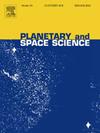Geomorphological study of the gullies in Penticton Crater, Mars: Classification and origin
IF 1.7
4区 物理与天体物理
Q3 ASTRONOMY & ASTROPHYSICS
引用次数: 0
Abstract
Penticton crater, a southern hemisphere mid-latitude crater on Mars, is covered with features that are typical examples of Martian gullies that resemble the terrestrial gullies on Earth. We studied the gullies present in the Penticton crater, classified them and interpreted their formation mechanism using a remote sensing approach. A wide variety of gullies, including the classic gullies, channel gullies, alcove-apron features, linear gullies and a distinct light-toned gully, were detected in the crater. With its diverse classes of gullies and absence of a preferential orientation trend between pole-facing and equator-facing slopes, the Penticton crater is ideal for observing present-day gully activity and studying the mechanism of modern gully formation. The geomorphological study points out prominent glacial features like lobate debris apron (LDA), lineated valley fill (LVF), and concentric crater fill (CCF) in the region. Extensive morphologic evidence suggests the previous existence of latitude-dependent mantle (LDM) on the pole-facing crater walls. The morphometric analysis using parameters like length, orientation, alcove and apron width of the gullies for all four Martian seasons suggests that the gullies are currently not active. The age estimated using crater size frequency distribution indicated that the study area is 5.5 ± 0.7 Ma, which falls in the range of the high obliquity period of Mars. We propose a rare scenario where there are multiple gully-forming mechanisms acting on the same crater. Our results imply that the gullies on the pole-facing slopes are formed on LDM due to destabilization triggered by the sublimation during the recent shift in Martian obliquity. However, morphometric parameters, including the apex slopes suggest that the gullies on the steeper equator-facing slope were most likely formed by the sliding of dry granular sand.
火星彭蒂克顿陨石坑沟壑的地貌研究:分类与成因
彭蒂克顿陨石坑是位于火星南半球的一个中纬度陨石坑,上面覆盖着与地球上的沟壑相似的火星沟壑的典型特征。我们研究了Penticton陨石坑中存在的沟壑,对它们进行了分类,并利用遥感方法解释了它们的形成机制。在陨石坑中发现了各种各样的沟壑,包括经典沟壑、沟渠沟壑、凹室-围裙特征、线性沟壑和一个独特的浅色沟壑。彭蒂克顿陨石坑的沟壑种类繁多,而且在面向极地和面向赤道的斜坡之间没有优先的朝向趋势,因此是观察当今沟壑活动和研究现代沟壑形成机制的理想场所。地貌研究指出了该地区突出的冰川特征,如叶状碎屑围裙(LDA)、线状山谷填充(LVF)和同心陨石坑填充(CCF)。大量的形态学证据表明,在面向极地的陨石坑壁上存在纬度相关地幔(LDM)。利用火星四季沟壑的长度、方向、凹形和围板宽度等参数进行的形态计量学分析表明,这些沟壑目前并不活跃。根据陨石坑大小频率分布估算的年龄为5.5±0.7 Ma,处于火星高倾角时期。我们提出了一种罕见的情况,即在同一个陨石坑上有多种形成沟壑的机制。我们的研究结果表明,由于最近火星倾角变化期间升华引发的不稳定,在LDM上形成了面向极地斜坡上的沟槽。然而,包括顶点坡度在内的形态测量参数表明,面向赤道的陡峭斜坡上的沟壑最有可能是由干燥颗粒砂的滑动形成的。
本文章由计算机程序翻译,如有差异,请以英文原文为准。
求助全文
约1分钟内获得全文
求助全文
来源期刊

Planetary and Space Science
地学天文-天文与天体物理
CiteScore
5.40
自引率
4.20%
发文量
126
审稿时长
15 weeks
期刊介绍:
Planetary and Space Science publishes original articles as well as short communications (letters). Ground-based and space-borne instrumentation and laboratory simulation of solar system processes are included. The following fields of planetary and solar system research are covered:
• Celestial mechanics, including dynamical evolution of the solar system, gravitational captures and resonances, relativistic effects, tracking and dynamics
• Cosmochemistry and origin, including all aspects of the formation and initial physical and chemical evolution of the solar system
• Terrestrial planets and satellites, including the physics of the interiors, geology and morphology of the surfaces, tectonics, mineralogy and dating
• Outer planets and satellites, including formation and evolution, remote sensing at all wavelengths and in situ measurements
• Planetary atmospheres, including formation and evolution, circulation and meteorology, boundary layers, remote sensing and laboratory simulation
• Planetary magnetospheres and ionospheres, including origin of magnetic fields, magnetospheric plasma and radiation belts, and their interaction with the sun, the solar wind and satellites
• Small bodies, dust and rings, including asteroids, comets and zodiacal light and their interaction with the solar radiation and the solar wind
• Exobiology, including origin of life, detection of planetary ecosystems and pre-biological phenomena in the solar system and laboratory simulations
• Extrasolar systems, including the detection and/or the detectability of exoplanets and planetary systems, their formation and evolution, the physical and chemical properties of the exoplanets
• History of planetary and space research
 求助内容:
求助内容: 应助结果提醒方式:
应助结果提醒方式:


